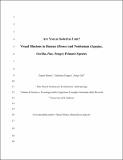Files in this item
Are you as fooled as I am? Visual illusions in human (Homo) and nonhuman (Sapajus, Gorilla, Pan, Pongo) primate species
Item metadata
| dc.contributor.author | Hanus, Daniel | |
| dc.contributor.author | Truppa, Valentina | |
| dc.contributor.author | Call, Josep | |
| dc.date.accessioned | 2022-11-17T16:30:22Z | |
| dc.date.available | 2022-11-17T16:30:22Z | |
| dc.date.issued | 2023-05-01 | |
| dc.identifier | 280272111 | |
| dc.identifier | ff4d3012-fcf3-4617-9f18-2f2a74fb3b1f | |
| dc.identifier | 85142271698 | |
| dc.identifier | 000875170000001 | |
| dc.identifier.citation | Hanus , D , Truppa , V & Call , J 2023 , ' Are you as fooled as I am? Visual illusions in human ( Homo ) and nonhuman ( Sapajus, Gorilla, Pan, Pongo ) primate species ' , Journal of Comparative Psychology , vol. 137 , no. 2 , pp. 80-89 . https://doi.org/10.1037/com0000326 | en |
| dc.identifier.issn | 0735-7036 | |
| dc.identifier.other | ORCID: /0000-0002-8597-8336/work/123196109 | |
| dc.identifier.uri | https://hdl.handle.net/10023/26428 | |
| dc.description.abstract | It has been argued that humans’ susceptibility to visual illusions does not simply reflect cognitive flaws but rather specific functional adaptations of our perceptual system. The data on cross-cultural differences in the perception of geometric illusions seemingly support this explanation. Little is known, however, about the developmental trajectories of such adaptations in humans, let alone a conclusive picture of the illusionary susceptibility in other primate species. So far, most developmental or comparative studies have tested single illusions with varying procedural implementations. The current study aims at overcoming these limitations by testing human subjects of four different age classes (3- to 5 year-old children and adults) and five non-human primate species (capuchin monkeys, bonobos, chimpanzees, gorillas and orangutans) with an identical setup in five well-known geometric illusions (Horizontal-vertical, Ebbinghaus, Mueller-Lyer, Ponzo, Sander). Two food items of identical size were presented on separate trays with surrounding paintings eliciting the illusion of size differences and subjects were required to choose one of the items. Four of the five illusions elicited a strong effect in adult humans, and older children showed a greater susceptibility to illusions than younger ones. In contrast, only two illusions (Ebbingaus and Horizontal-vertical) elicited a mild effect on nonhuman primates with high variation within species and little variation between species. Our results suggests that humans learn to see illusions as they develop during childhood. They also suggest that future work should address how nonhuman primates’ experience of these illusion changes throughout their development. | |
| dc.format.extent | 10 | |
| dc.format.extent | 512655 | |
| dc.language.iso | eng | |
| dc.relation.ispartof | Journal of Comparative Psychology | en |
| dc.subject | Visual illusions | en |
| dc.subject | Geometrical illusions | en |
| dc.subject | Comparative cognition | en |
| dc.subject | Primate visual perception | en |
| dc.subject | BF Psychology | en |
| dc.subject | NDAS | en |
| dc.subject | MCC | en |
| dc.subject.lcc | BF | en |
| dc.title | Are you as fooled as I am? Visual illusions in human (Homo) and nonhuman (Sapajus, Gorilla, Pan, Pongo) primate species | en |
| dc.type | Journal article | en |
| dc.contributor.institution | University of St Andrews. Centre for Social Learning & Cognitive Evolution | en |
| dc.contributor.institution | University of St Andrews. School of Psychology and Neuroscience | en |
| dc.contributor.institution | University of St Andrews. Institute of Behavioural and Neural Sciences | en |
| dc.identifier.doi | 10.1037/com0000326 | |
| dc.description.status | Peer reviewed | en |
| dc.date.embargoedUntil | 2022-10-31 |
This item appears in the following Collection(s)
Items in the St Andrews Research Repository are protected by copyright, with all rights reserved, unless otherwise indicated.

